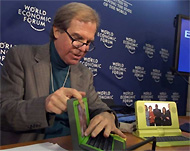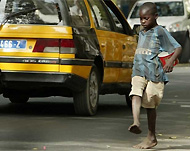A revolution in a laptop
After an inauspicious birth 25 years ago when Ronnie Reagan and Maggie Thatcher were in their prime, the IBM 5150, retailing at $1,565, ushered in the age of the modern PC.

A quarter of a century on the legacy of the PC is ubiquitous.
Chances are one is at work in every facet of your daily life – chances are, you are using one right now.
While software applications and the companies that develop them have become the main drivers in today’s information society, the CM1, more commonly known as the $100 laptop, could take over where the venerable 5150 left off – becoming one of the enduring pieces of techno hardware in the next 25 years.
 |
|
Negroponte says the new laptop |
The CM1 is the crown jewel of the One Laptop per Child (OLPC) project, a non-profit venture that aims to do exactly what it says and arm underprivileged children in rural areas in underdeveloped societies with their very own personal computer.
The project is intended to connect them both to the wider world and to their peers, and is the brainchild of technology veteran Nicholas Negroponte, the co-founder of the Massachusetts Institute of Technology’s influential Media Lab.
OLPC, he told Aljazeera, is a project that has been many years in the making.
“You will find mention in Media Lab work of low cost machines since the 1980s,” he says. “Doing a $100 laptop became possible now. The time is right. It was not an ‘ah ha’ 18 months ago, but the confluence of every vector in my life.”
‘Learning learning’
 |
|
The project aims to build peer- |
The idea of using technology to enhance the lot of the world’s poor and uneducated is indeed a deep-seated and well-versed one.
Negroponte insists that by targeting the next generation his project will prosper where others have met with limited success.
“The simple fact is that about half of the world’s billion children live in remote, rural and poor parts of the world where school is less than 3 hours per day and teachers often do not have a 6th grade education,” he says. “There just is no way to fix that without leveraging the children.”
OLPC aims to exert such leverage through the use of peer-to-peer communications. The theory being that if children are given the basic tools and are able to interact they will be able to learn, well, learning.
Negroponte simply refers to it as “learning learning.”
He says the $100 laptop “is the intersection of three experiences: the book, the mobile and the Internet”.
‘Constructionism’
“The basic functions are those of any laptop, with added emphasis on peer-to-peer communications, graphics, sound and what we call constructionism – learning by making things. So the laptop will have a browser (obviously) but also tools like Logo, Squeak and eBook readers. However, being Open Source, it will grow boundlessly.”
|
“They talk about computer literacy, as if kids should learn Power Point, Word and Excel” Nicholas Negroponte |
The CM1 has been designed by academics and industry experts and is built to be low-cost, power-efficient, durable and, most importantly, kid-friendly.
As an open-source machine it is aimed at being cost-effective, operates on a “skinny” version of the Linux operating system and has an estimated lifetime of at least five years.
Some within the computer industry have dismissed the CM1 as nothing more than a toy or gadget, but Negroponte feels that some decision-makers and representatives of big business in the West often miss the point.
“Most Western governments and big businesses think in terms of training teachers and building more schools. Worse, they talk about computer literacy, as if kids should learn Power Point, Word and Excel. That is just too absurd and these well-meaning people should understand that learning learning is what is needed.”
Mass production
OLPC aims to have test machines ready in November, to have pre-releases ready in February next year and begin mass production of the CM1 in April. The latter half of 2007 has been earmarked as the beginning of scale, depending on shipping methods and local distribution
 |
|
OLPC aims to turn the tide of |
The initial aim is to see a million children, several million family members and at least 50,000 teachers actively using the laptops for learning.
The initial roll-out will target Brazil, Argentina, Thailand and Nigeria – countries Negroponte says were chosen to represent each continent and give a good geo-cultural mix. He says the focus is very much on rural communities.
“This is really important to rural parts of the world. To be rural has meant to be poor. The history of development has been synonymous with urbanisation, and yet the worst form of poverty is urban poverty. If we could bring education, health services and jobs to remote places, that tide can change.”
There is the risk that by putting the latest modern technology into the hands of children they will be subjected to the latest modern dangers such as viruses, and internet paedophiles.
Negroponte acknowledges the risk but declares he “would not argue against literacy because people can write nasty material, nor would I argue against cell phones because a terrorist can use them too.”
There area also issues in accessing more closed and undemocratic societies where clampdowns on personal freedoms, particularly via the control of the media and the Internet, are common.
Connectivity
However, says Negroponte, “more closed societies are guardedly open about the idea, because any official or wealthy person in even the most oppressed parts of the world will buy a laptop and provide connectivity to their own children. They understand full well that education will allow their children to achieve and prosper”.
Success for the project, he says, would be seeing OLPC initiatives set-up in all the world’s developing countries by 2009.
The project has plenty of backing, with Kofi Annan believing “it holds the promise of major advances in economic and social development”.
Negroponte goes further still, equating it to the impact of the PC in the last 25 years.
“If OLPC is successful, whatever success means, the impact will be so large in terms of peace and elimination of poverty, that changes to the PC industry will be noise by comparison. The best thing that could happen to us is that people copy what we do, in any and every way.”